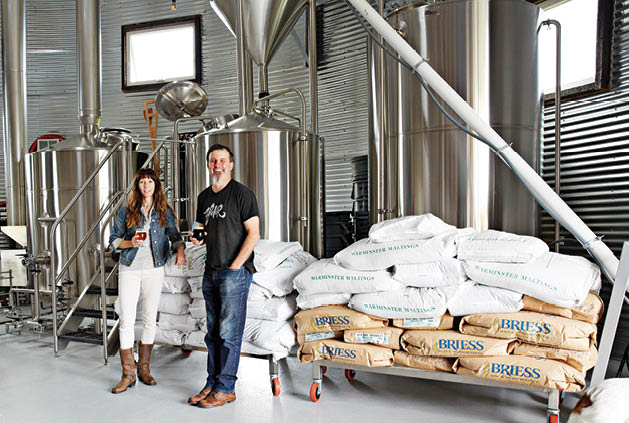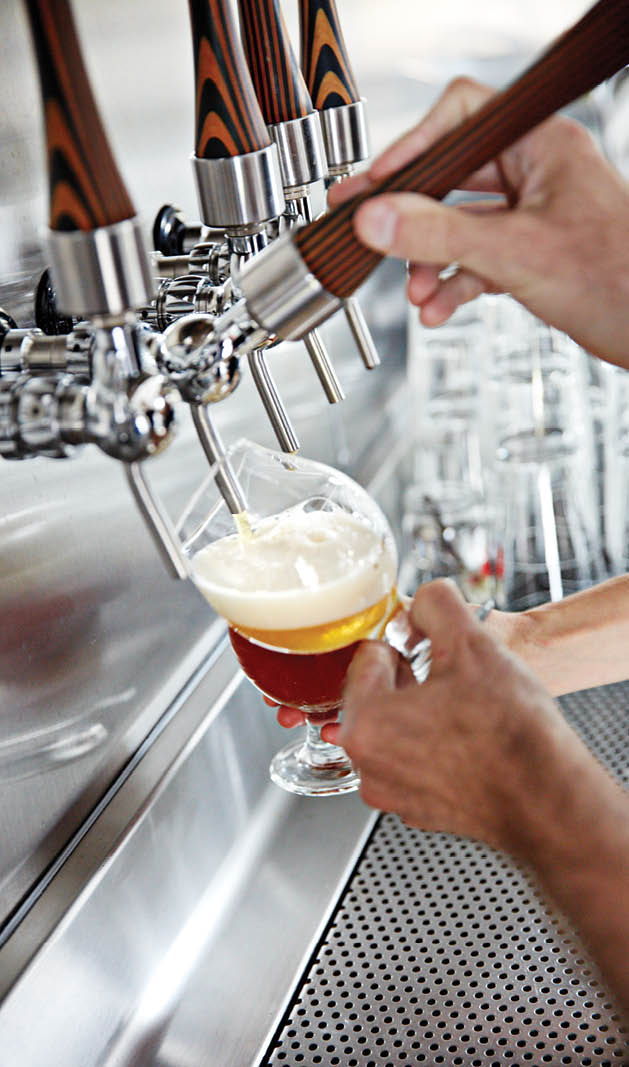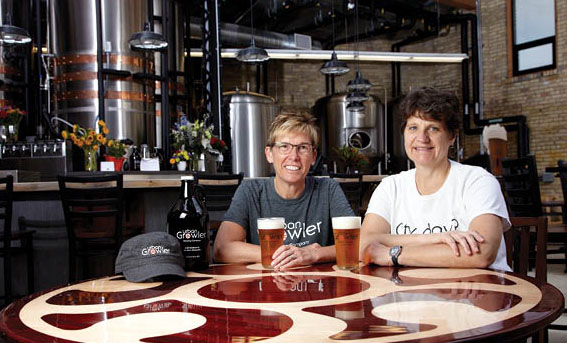Phil Platt is a walking Rolodex of Minnesota breweries. Over a pint of Urban Growler’s rye IPA, the executive director of the Minnesota Craft Brewers Guild rattles them off like he’s cruising along a mental map of the state’s brewing concentrations in Northeast Minneapolis, Duluth and Saint Paul. He’ll tell you all about the outliers, too—Lupulin in Big Lake, Spilled Grain in Annandale, Take 16 in Luverne.
“What we’re returning to is the 1800s when every town had their own brewery,” Platt says. “Before refrigeration, they had to.”
If refrigeration marked the decline of the small-town brewery, it’s the locavore movement that brought it back to life. Our growing commitment to what is fresh, tasty and local has elevated Minnesota’s status in the national craft brewing scene. In the last five years, the Guild has gained nearly 60 new members, and since the 2011 Surly Bill allowed for onsite pint sales, industrial taprooms have been popping up at an unprecedented rate.
If there exists any air of competition between member breweries, it’s hard to pick up on. What each has to offer is so distinct—from their beer to their branding to the way they engage their community—that it seems almost strange to view them as contenders in the same race.
With that, let’s meet three of Saint Paul’s recent additions. They all opened within a year of one another and their taprooms all lie within a 6-mile stretch. But each seems assured, to some extent, of two things: that its distinctive ethos has commanded an audience, and that that audience is here to stay.
Tin Whiskers Brewing Company
Est. 2014
Find their brews at Sawatdee, Rival House, Public Kitchen + Bar, The Bulldog Lowertown
In the entryway of Tin Whiskers’ downtown taproom is a mural of a giant robot, standing hero-like against a circuit board silhouette. The robot raises a frothy pint in a silent “Cheers” to the entire room—or maybe it’s saying, “Sláinte,” the Gaelic toast with which Tin Whiskers president and founder Jeff Moriarty closes all his emails.
Moriarty and co-founders Jake Johnson and George Kellerman met at the University of Minnesota, where all three were studying electrical engineering. After college, they started to hear a lot about homebrewing. After a bit of research and a trip to Northern Brewer, Moriarty and Johnson cooked up their first batch of beer. Their affinity for the process was instant and not altogether surprising.
“To me, engineering was always the combination of science with art,” Moriarty says. “Brewing is the same way.”
The co-founders’ shared profession runs through every aspect of Tin Whiskers’ branding, from its name (an electrical engineering term) to its beer labels (also electrical engineering terms) to the custom-made circuit boards they use for serving flights. But nowhere is their scientific training applied more thoroughly and advantageously than in their process for developing new brews.
Tin Whiskers prides itself on creating technically excellent and innovative beers. Its single-barrel pilot plant allows for the tweaks that lead to technical excellence and the risks that lead to innovation.
“If the beer doesn’t turn out, we’re only out a couple hundred bucks,” Moriarty explains. “Whereas if you’re doing everything on a big system, your risk-taking is very much diminished.”
The pilot system has ushered in all kinds of ingredient mash-ups like cactus and pineapple, jasmine and ginger, orange peel and coriander. Its biggest payoff has been the best-selling Wheatstone Bridge, an American wheat brewed with honey and chamomile tea. And right now, Tin Whiskers is throwing 300 pounds of pumpkin into the mash for their seasonal Schottky pumpkin ale, a potion that tastes like pumpkin pie but drinks dry like a beer.
To communicate where a beer falls in the development process, Tin Whiskers has adapted standard circuit-board stages to the brewing world. A “singleton” is a one-off that may not be around for long; “alpha” and “beta” beers are subject to changes and tweaks; and a “production” is right where it needs to be. Moriarty says it’s a way of telling customers, “If you don’t like it this time, well, we’re not done fixing it.”


Bang Brewing
Est. 2013
Find their brews at Ngon Vietnamese Bistro, the Muddy Pig, Groveland Tap, Amsterdam Bar & Hall, Foxy Falafel
Years before Sandy and Jay Boss Febbo wrote their business plan, they knew they’d call their brewery “Bang.” The typographical term for an exclamation point, bang is common to the lexicons of advertising—Sandy’s industry—and Jay’s former field of software engineering.
“In all of our homebrew experiments, Jay would start each batch with a bang,” Sandy says, “because he was so excited to have another one underway.”
This was the first of many decisions that came down on the side of simplicity. Just look at their brewhouse, a circular grain bin on a parcel of native prairie. Now a gleaming monument to Bang’s minimalism and efficiency, the bin was first presented as an almost off-hand suggestion. Architect Geoffrey Warner of Alchemy and design partner Scott Erwin were knocking through a third-round brainstorm when the idea slipped from Ervin’s mouth: Grain bin
“He said it like a thought just passed through his head and came out like a joke,” Sandy remembers. “And everyone went, yes.”
Bang Brewing opened its bin in September 2013 with Neat, a sparkling bitter ale that came out of their homebrewing control recipe. It’s about as simple as beer formulas come—a base malt and one hop—but according to Sandy, it’s a bear to brew.
“When you don’t have anything to hide behind—no superfluous flavors to mask an imperfection—you’ve got to get it right.”
Next on tap was an American mild dubbed Minn. The dark ale that followed Minn had to be called Nice, so when they pull their version of a Black and Tan, they’re pouring a Minn-Nice.
Bang, Neat, Minn, Nice. Notice a trend? The four-letter labels make for a clean-looking beer list and provide a simple mold that jibes well with Bang’s unadorned taproom, featuring a production table that doubles as a bar. Nevertheless, it’s a mold that Bang is willing to break.
“We’re just riding the wave now,” Sandy says, “but we reserve the right to change our mind.”
And that, it seems, is a perfect characterization of the Bang outlook. To keep the process efficient and the brews up to standard, Jay and Sandy have to be flexible—and so do their customers.
Yes, the bin gets hot without air conditioning, but they’ll open the windows and pour cold beers; yes, they’ll have the Bloody Neats, but only when the heirloom tomatoes are in season; and perhaps most importantly, yes, they are organic—the only dedicated organic brewery in the state.
Finding farmers who share their values is essential to Bang; the same can be said of its partnerships with local businesses. Customers can watch these collaborations take place at tap where Sandy and Jay infuse freshly pulled beer with cold-pressed coffee from Kopplin’s, tomato juice from Peeps Hot Box and pepper sauce from Hai Truong of Ngon Bistro. They both say if they walked away today, it all would have been worth it for these relationships they’ve formed.
“We keep meeting people who are really connecting with what we’re trying to do,” Sandy says. “The community that we’re discovering is mind-blowing.”


Urban Growler Brewing Co.
Est. 2014
Find their brews at Muffuletta, the Nook, Bacio, Red Cow, Black Sheep, the Dubliner Pub
Founded by head brewer Deb Loch and partner Jill Pavlak, Urban Growler has been duly celebrated for being the first woman-owned and -brewed microbrewery in Minnesota. The significance of this distinction doesn’t lie so much in day-to-day operations but in what it took to get there. What makes their accomplishment impressive is the doubt they overcame—not least, their own.
“I think we were our biggest critics,” Pavlak says. “We were the hardest on ourselves.”
It didn’t help, though, that others were questioning their ability. The two women jumped through hoops for six months with one bank, which wouldn’t finance their small business loan; their second bank backed out just when they were ready to sign a lease. “That was the most frustrating part of the process,” Pavlak says. “We had gone above and beyond in experience and training. We were totally overprepared.”
Those preparations had begun about six years earlier when Pavlak quit a consuming job in commissioned sales and started hosting at Longfellow Grill, where the management provided helpful insight into running a business. “I was making eight bucks an hour, but I was happier,” Pavlak says.
Loch, a biomedical and product engineer at the time, saw a transformation in her partner and wanted the same for herself. The two headed to Chicago for a “Start Your Own Brewery” course at the Siebel Institute of Technology, after which Loch took a leave of absence from her job. Loch became an assistant brewer at Minocqua Brewing Co. in Wisconsin and later sought apprenticeship from Summit’s Mark Stutrud. Prior to the apprenticeship, she enrolled in the master brewers program at UC Davis.
Armed with mentors, references and more formal credentials than many successful brewers can claim, Loch and Pavlak were denied by more than 10 banks before Dane Breimhorst of Burning Brothers handed them his banker’s card for Pioneer Bank in Mankato. Within two weeks they were ready to go.
Now 14 months in business, Urban Growler has no trouble attracting customers with its popular food menu. Also worthy of note are their Plow to Pint beers. A celebration of seasonal produce and the people who grow it, this series has featured cranberries from Warrens, Wisc., blueberries from Clearwater and rhubarb from the St. Paul Farmers Market. The brewery has already undergone a kitchen expansion and is making plans for additional square footage for the brewing operations.
Despite their success, there are still moments where Pavlak reminds herself they are going to make it.
“We don’t have time to panic anymore,” she says. “We’re all in.”










